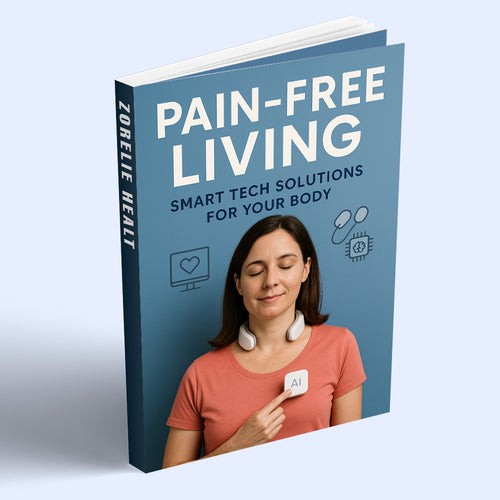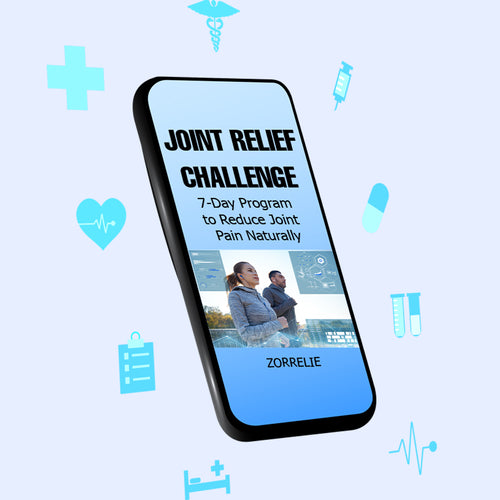Introduction
Pain is our body’s warning system. Yet, in our fast-paced modern life, many of us dismiss chronic aches and pains — “it’ll go away,” “just resting will fix it,” or “I don’t have time to treat it.” But what happens if we ignore body pain persistently?
In this comprehensive article, Dr. Jonathan Miles, DPT, PhD, an orthopedic rehabilitation specialist, guides you through:
-
The hidden cost of ignoring body pain
-
How minor discomfort escalates into chronic problems
-
Natural, evidence-based strategies to heal
-
How to use home therapy devices (massage guns, heating pads) wisely
-
Why Zorelie’s product solutions (link to Zorelie.co/collections/all) can support you
This is not merely motivational fluff — it’s grounded in research, experience, and a long-term vision for your body’s resilience.
1. The Hidden Risks of Ignoring Pain
1.1 From acute to chronic: the slippery slope
When you ignore pain signals, what begins as a mild ache (say neck tightness) can progress into chronic pain syndrome. Studies show that patients’ expectations and attitudes about pain influence outcomes. PMC Chronic pain can alter nerve sensitivity, leading to central sensitization, making even mild stimuli painful.
1.2 Compensation, posture distortion & secondary injuries
To avoid pain in one area, you unconsciously shift your posture or gait. Over time, this compensation stresses other joints (hips, knees, back). For instance, forward head posture increases load on cervical discs. BioMed Central+1
1.3 Functional decline & quality of life
Persistent pain reduces mobility, strength, and endurance. It may affect sleep, mood, productivity, and even mental health. The body slowly “shrinks” — less movement, more stiffness.
1.4 Cost burden
Ignoring pain can lead to expensive medical interventions later: imaging, medications, surgery, rehab. Prevention and early intervention cost far less — financially, emotionally, physically.
2. Understanding the Causes: Why Body Pain Persists
2.1 Muscle imbalance & weakness
Weak stabilizer muscles (neck, core) make you more vulnerable to strain. Research shows strengthening neck muscles can moderate pain in the short term. MDPI
2.2 Poor posture & prolonged postural loading
The modern world demands hours in front of screens. The cervical spine, when flexed forward, experiences higher compressive force (CF). BioMed Central Over time, that load causes microtrauma.
2.3 Inadequate recovery & overuse
Even “moderate” daily stress becomes cumulative if rest and recovery are neglected. Microtears, inflammation, and incomplete repair lead to chronic discomfort.
2.4 Psychological stress & pain amplification
Stress, anxiety, sleep deprivation amplify pain perception via neurological pathways. Psychological state impacts musculoskeletal health.
2.5 Inflammatory triggers & lifestyle factors
Poor diet, sedentary behavior, smoking, dehydration — all can stoke systemic inflammation, making tissues more sensitive.
3. Natural Strategies to Heal and Prevent Pain (Dr. Miles’ Protocol)
Below is a 5-phase protocol you can integrate into your daily life, anchored in research and clinical practice.
3.1 Awareness & early action
-
Don’t dismiss pain — track intensity, locations, triggers.
-
Use a pain journal: time, activity, aggravators, relief.
-
Begin gentle movement early — “micro-mobilization” helps circulation.
3.2 Posture correction & ergonomics
-
Use ergonomic setups: monitor at eye-level, chair adjusted.
-
Implement “posture checks” every 30 mins.
-
Use posture correctors or supportive devices as reminder cues.
3.3 Targeted exercise & strength training
-
Focus on weak or inhibited muscles (deep neck flexors, scapular stabilizers, core).
-
Use controlled isometric / eccentric loads before dynamic exercises.
-
Gradually progress load under controlled supervision.
3.4 Soft-tissue therapies & active recovery
-
Self-massage, foam rolling, myofascial release.
-
Use percussive devices (massage guns) or heating pads to improve circulation and relax tight muscles.
-
Light stretching and mobility drills, not aggressive forcing.
3.5 Regular rest, sleep hygiene, and stress management
-
Ensure restful sleep with supportive pillows.
-
Use breathing techniques, mindfulness, or yoga to downregulate stress.
-
Hydrate well, anti-inflammatory nutrition, avoid extremes.
4. How Home Therapy Devices Can Support You (Smart Use, Not Overuse)
When correctly used, home devices can accelerate recovery and maintain wellness — but they’re tools, not fixes alone.
4.1 Why they help
-
Increase local blood flow
-
Reduce muscle tightness or trigger points
-
Provide relaxation cues and comfort
4.2 Best practices
-
Use devices only on healthy soft tissue — avoid bony or injured areas.
-
Limit sessions (e.g. ≤ 10 minutes per muscle group).
-
Alternate modalities (heat, massage) rather than one only.
4.3 Product spotlights from Zorelie
-
Massage Gun Deep Tissue Percussion Massager Gun — ideal for targeted deep muscle relief. (Link to product page)
-
(Nếu có) Heating pad / neck massager trong bộ sưu tập Zorelie cũng nên được nhấn mạnh ở đây: “For gentle warmth + relaxation, check Zorelie’s heating pad / neck massager offerings at Zorelie.co.”
Make sure to integrate a link vào tên sản phẩm để dẫn khách mua.
5. Sample Weekly Plan to Reset & Repair
| Day | Focus | Strategies |
|---|---|---|
| Mon | Awareness & movement | Gentle mobility, posture breaks, light self-massage |
| Tue | Strength initiation | Deep neck / scapular isometrics |
| Wed | Soft-tissue + heat | Use heating pad + light massage |
| Thu | Progressive load | Add light resistance or bands |
| Fri | Recovery emphasis | Yoga / stretch / breathing |
| Sat | Moderate movement | Walk, swim, low-impact cardio |
| Sun | Rest & reset | Sleep, nutrition, stress reset |
Ensure to rest between tasks and listen to your body.
6. Case Example (Hypothetical Client Journey)
Sarah, a 32-year-old content writer, began suffering neck-shoulder pain after months of working remotely. She ignored the slight ache until stiffness became chronic.
Under Dr. Miles protocol, she began gentle mobility, used a massage gun 3x/week, improved her workstation ergonomics, and gradually added strength training. After 8 weeks, her pain dropped by 70%, her posture improved, and she no longer relied on painkillers.
This kind of narrative demonstrates feasibility and empathy for readers.
7. Long-Term Vision & Preventive Mindset
Your body is a long-term investment. Ignoring pain is like neglecting warning signs in a car — you might still drive, but eventually something fails. Use these guidelines consistently, not just when you feel “bad.”
Always revisit posture, recovery habits, movement, and stress. Products like massage guns, heating pads, or posture supports are tools — they amplify your efforts, not replace them.
Conclusion
By acknowledging pain early, applying science-backed strategies, and using intelligent devices where appropriate, you can prevent the hidden costs of chronic discomfort.
Explore Zorelie’s curated wellness and pain-relief tools to support your journey. Begin with one habit, commit for 4–8 weeks, and observe how your body transforms.
Let Dr. Jonathan Miles’ philosophy guide you: pain isn’t your identity — your resilience is.





















